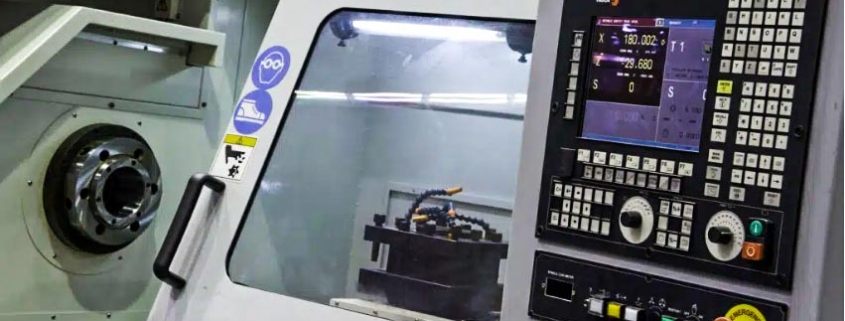CNC machines: guide to numerical control
1. What is CNC
CNC (Computerized Numerical Control), or Computer Numerical Control in English, It is a widespread system in engineering to process materials and parts with minimal human intervention. The CNC technique derives from numerical control, an automated system for machine tools that are operated by means of commands through handwheels or levers. However, these machines have evolved and now allow their control through software and a computer in order to further automate the process and offer better performance.
The operation of these CNC systems is quite simple to understand. It is based on the machining of a piece through the use of coordinates that will specify the movement of the tool (cutting, drilling, milling, welding…). Similar to the operation of a 3D printer, which could also be understood as a CNC machine, only instead of machining, what it does is add layers of material to build a part.
And just like 3D printers, you can have multiple axes, like the X, Y and Z, being able to carry out longitudinal, vertical and transversal displacements respectively. Through some servomotors I stepper motors, the tool will be moved to the exact point indicated by the computer software, and the machining will be carried out quickly and with the highest precision.
Before the invention of the CNC, labor was required to handle the tools manually, but the possible failures they could commit affected quality, repeatability, costs and decreased production. For example, imagine an employee in an aluminum shop who wants to drill frames for a window. This task requires that:
- The operator picks up the piece.
- Put it on the work table.
- Put the appropriate bit in the drill.
- And drill.
This to make a single hole is not a problem, but imagine that hundreds or thousands of them need to be made to maintain a considerable production and in the shortest possible time, in addition to all the holes being the same. In that case, the workforce is not adequate, and that is where cnc machines brought great improvements to the industry. In this case, the steps would be:
- Make sure the machine is fed with material (sometimes they might even have automatic feeding).
- Start it with the necessary programming (it may be necessary only once and indicate the number of repetitions).
- And she will be in charge of making the perforations with precision and repeating them as many times as necessary, without the need for the operator to intervene.
In addition, can work faster than an operator and does not get tired, so all are advantages for the industry or workshop.
2. What are CNC machines and how does it work?

An CNC machine is a kind of machining machine operated by computer numerical control.. In this way, process automation is achieved by establishing precise coordinates for cutting, welding, milling, molding, grinding, placing parts, etc., of all kinds of materials, from soft ones such as polymers, foami, MDF, or wood, even harder such as marble, metal, rocks, etc.
Likewise, CNC machines allow for a sophisticated system of feedback that constantly monitors and adjusts the speed and position of the tools used for machining, without the need for such frequent manual maintenance. Even some more advanced ones have intelligent systems to detect problems, control the quality of the work or part, etc., or be interconnected if it is an industry 4.0.
It is important to note that some CNC machines they work differently:
- point to point control: In this type of CNC machines, the start and end points of each path will be established.
- paraxial control: in them it is possible to control the movement speed of the pieces.
- interpolate control: they carry out machining in any way parallel to their axes.
3. What is a CNC machine made of?

When it comes to detailing the parts or components of a CNC machine, the following essential elements can be cited:
Input device
The word input device from a CNC machine to the system that is used to be able to load or modify the data for the machining process. For example, it can be a control panel, a touch screen, etc. That is, an interface to allow the machine operator to activate and control the machine.
Control unit or controller
Is digital electronic system which will be in charge of interpreting the entered data and generating a series of control signals to control the movement of the servomotors to move the work head through the axes and the tool so that they do exactly what the program entered by the user indicates .
Tools
La tool It is one of the most essential components, since it is the one that actually performs the machining, the one that is in contact with the piece that is being processed. It can be a multi-tool head, being able to carry out several different tasks, or also individual fixed or interchangeable tools. For example: drill bit, cutter, milling cutter, welding tip, etc.
In addition, it is important to note that there may be various types of CNC machines in terms of their type and number of axles:
- 3 axes: are the most common, with an X, Y, and Z axis.
- 4 axes: like some routers or CNC routers that add an A axis to the previous three. This allows the spindle to move from left to right to process three surfaces at the same time, being able to engrave flat or in 3D. They are ideal for carving wood, metals, complex patterns, etc.
- rotary axis– It has a rotating spindle for the tool, which allows you to process four surfaces simultaneously. These types of machines are used for machining cylindrical parts, wooden statues, complex metal elements, etc.
Fastening or support system
Is place where the piece is anchored to carry out the machining process without it moving. Depending on the system, it could be of different types, with or without anchors. In addition, some need extras, such as dust collection systems, or water jet cutting, which would require a water tank or reservoir to collect and dissipate the force of the jet once it passes through the part.
These systems are often called also bed or table. Many of them are usually made of materials such as aluminium, when the pieces need to be attached to the table, to process cylinders or complex shapes. Instead, the vacuum bed or table will vacuum the part without clamping it, allowing for a higher degree of precision, less agitation during use, and a greater degree of freedom.
Feedback devices (servomotors)
There are only these types of devices. feedback on CNC machines that use servo motors. In the others it is not necessary.
Monitor
In addition to all of the above, there may also be a information or monitoring system of the machining process itself. This can be through the same interface from which it is operated or independently.
Other parts
In addition to the above, it should be noted two essential elements plus:
- Engines: are the devices that move or activate the machining tool according to the data received from the control unit.
- Servo: tolerates high speeds, so you can cut, drill, etc. Ideal for quiet, stable work, and for intricate patterns.
- Stepper: These stepper motors are priced lower, but are used for more basic engraving or movement. They are easy to control, reliable and highly accurate, making them suitable where maximum precision is needed.
- Spindle: This element of a CNC machine can have two types of possible cooling or cooling system: By air: They are cooled simply by a fan that cools the spindle, and are cheaper, easier to maintain and use; By water: They use water for cooling. It is more expensive, complex, and difficult to maintain, but it generally lasts longer, is more efficient, and is quieter.




